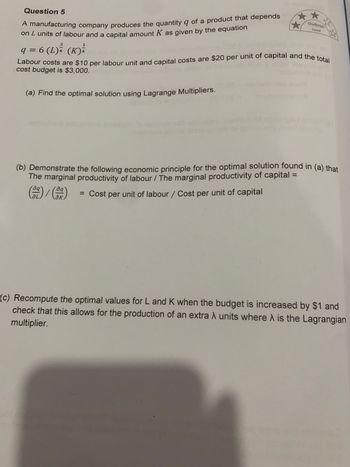
ENGR.ECONOMIC ANALYSIS
14th Edition
ISBN: 9780190931919
Author: NEWNAN
Publisher: Oxford University Press
expand_more
expand_more
format_list_bulleted
Question

Transcribed Image Text:Question 5
A manufacturing company produces the quantity q of a product that depends
on I units of labour and a capital amount K as given by the equation
3
1
q = 6 (L) ³² (K) ²
Labour costs are $10 per labour unit and capital costs are $20 per unit of capital and the total
cost budget is $3,000.
(a) Find the optimal solution using Lagrange Multipliers.
G
(b) Demonstrate the following economic principle for the optimal solution found in (a) that
The marginal productivity of labour / The marginal productivity of capital =
aq
= Cost per unit of labour / Cost per unit of capital
aq
☆
ƏL
Challenge
Level
(c) Recompute the optimal values for L and K when the budget is increased by $1 and
check that this allows for the production of an extra λ units where is the Lagrangian
multiplier.
Expert Solution
This question has been solved!
Explore an expertly crafted, step-by-step solution for a thorough understanding of key concepts.
Step 1: a. Finding optimal solution using Lagrange multiplier
VIEW Step 2: Continuation of first step
VIEW Step 3: Continuation of previous step
VIEW Step 4: Proving equilibrium condition using the optimal solution.
VIEW Step 5: Continuation of previous step
VIEW Step 6: Proving if the extra incremental output produced is equal to the Lagrange multiplier
VIEW Step 7: Continuation of previous step
VIEW Solution
VIEW Step by stepSolved in 8 steps with 8 images

Knowledge Booster
Learn more about
Need a deep-dive on the concept behind this application? Look no further. Learn more about this topic, economics and related others by exploring similar questions and additional content below.Similar questions
- The Brain Bucket Company (BBC) produces helmets for winter sports. It has production facilities in Toronto and Winnipeg. The production function for the Toronto facility is Qr LT, (1) where LT is the quantity of labour hired in Toronto. The production function for the Winnipeg facility is VLw. (2) Qw where Lw is the quantity of labour hired in Winnipeg. The wage rate in Winnipeg is one and the wage rate in Toronto is two. Answer the following: (a) If BBC wishes to produce Q helmets at the lowest possible cost, how should it distribute production between the two cities? Use your answer to find a function showing the cost of producing Q helmets.arrow_forwardLet a two-output cost function be given byarrow_forwardEconomies of Scale. Figure 7.10b illustrates the situation in which a larger plant can attain a lower minimum average cost than a smaller plant. That is, economies of scale (or increas- ing returns to scale) exist. This is evident from the fact that the larger firm's ATC curve falls below the dashed line in the graph (m, is less than c). The greater efficiency of the large factory might come from any of several sources. This is the situation Elon Musk was count- ing on for his Shanghai gigafactory.arrow_forward
- .A company can sell its only product and in a perfectly competitive market at a price of 15. To produce it, it must purchase two production inputs: labor (x1) and machinery (x2). Initially, the company only has 1 machine and it is not possible to change this in the short term. Inputs are purchased in competitive markets with respective prices (w1, w2) = (5,10). The production function is as follows: 3 2/3 1/3 f(x,x2) a) Present the problem of maximization of the company. b) Find the first order condition that must be solved to find the optimal level of supplies. c) Find the optimal input level x1 that the company must contract in the above problem to maximize your profits.arrow_forwardThe daily output at a factory is Q(K, L) = 144KL units, where K is the capital investment measured in units of $1000 and L is the size of the labor force measured in worker-hours. (a) Compute the daily output if the capital investment is $139,000 and the size of the labor force is 1025 worker-hours. (b) What will the output be if both the level of capital investment and the size of the labor force are cut in half?arrow_forward
arrow_back_ios
arrow_forward_ios
Recommended textbooks for you

 Principles of Economics (12th Edition)EconomicsISBN:9780134078779Author:Karl E. Case, Ray C. Fair, Sharon E. OsterPublisher:PEARSON
Principles of Economics (12th Edition)EconomicsISBN:9780134078779Author:Karl E. Case, Ray C. Fair, Sharon E. OsterPublisher:PEARSON Engineering Economy (17th Edition)EconomicsISBN:9780134870069Author:William G. Sullivan, Elin M. Wicks, C. Patrick KoellingPublisher:PEARSON
Engineering Economy (17th Edition)EconomicsISBN:9780134870069Author:William G. Sullivan, Elin M. Wicks, C. Patrick KoellingPublisher:PEARSON Principles of Economics (MindTap Course List)EconomicsISBN:9781305585126Author:N. Gregory MankiwPublisher:Cengage Learning
Principles of Economics (MindTap Course List)EconomicsISBN:9781305585126Author:N. Gregory MankiwPublisher:Cengage Learning Managerial Economics: A Problem Solving ApproachEconomicsISBN:9781337106665Author:Luke M. Froeb, Brian T. McCann, Michael R. Ward, Mike ShorPublisher:Cengage Learning
Managerial Economics: A Problem Solving ApproachEconomicsISBN:9781337106665Author:Luke M. Froeb, Brian T. McCann, Michael R. Ward, Mike ShorPublisher:Cengage Learning Managerial Economics & Business Strategy (Mcgraw-...EconomicsISBN:9781259290619Author:Michael Baye, Jeff PrincePublisher:McGraw-Hill Education
Managerial Economics & Business Strategy (Mcgraw-...EconomicsISBN:9781259290619Author:Michael Baye, Jeff PrincePublisher:McGraw-Hill Education


Principles of Economics (12th Edition)
Economics
ISBN:9780134078779
Author:Karl E. Case, Ray C. Fair, Sharon E. Oster
Publisher:PEARSON

Engineering Economy (17th Edition)
Economics
ISBN:9780134870069
Author:William G. Sullivan, Elin M. Wicks, C. Patrick Koelling
Publisher:PEARSON

Principles of Economics (MindTap Course List)
Economics
ISBN:9781305585126
Author:N. Gregory Mankiw
Publisher:Cengage Learning

Managerial Economics: A Problem Solving Approach
Economics
ISBN:9781337106665
Author:Luke M. Froeb, Brian T. McCann, Michael R. Ward, Mike Shor
Publisher:Cengage Learning

Managerial Economics & Business Strategy (Mcgraw-...
Economics
ISBN:9781259290619
Author:Michael Baye, Jeff Prince
Publisher:McGraw-Hill Education